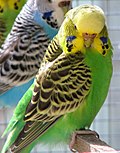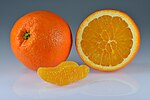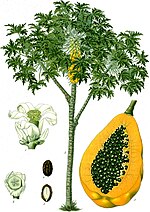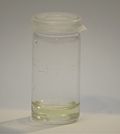Orange carotenoid protein (OCP) is a water-soluble protein which plays a role in photoprotection in diverse cyanobacteria. It is the only photoactive protein...
27 KB (2,907 words) - 18:30, 28 December 2023
biology the orange carotenoid N-terminal domain is a protein domain found predominantly at the N-terminus of the Orange carotenoid protein (OCP), and is...
5 KB (531 words) - 22:42, 12 August 2023
Carotenoids (/kəˈrɒtɪnɔɪd/) are yellow, orange, and red organic pigments that are produced by plants and algae, as well as several bacteria, archaea, and...
44 KB (5,232 words) - 22:37, 14 April 2024
photosynthesis in chloroplasts and cyanobacteria. He discovered the Orange Carotenoid Protein of cyanobacteria in 1981 and helped solve its crystal structure...
2 KB (150 words) - 13:14, 6 July 2021
within dedicated carotenoid proteins such as the orange carotenoid protein of cyanobacteria. Bacteria produce pigments such as carotenoids, melanin, violacein...
32 KB (3,908 words) - 20:24, 18 April 2024
cyanobacteria. It prevents accumulation of the red photoactivated form of orange carotenoid protein (OCP), thereby reducing the amount of fluorescence quenching that...
5 KB (588 words) - 12:04, 29 August 2021
Β-Carotene (redirect from List of orange foods)
inherited condition of sunlight sensitivity. β-carotene is the most common carotenoid in plants. When used as a food coloring, it has the E number E160a.: 119 ...
34 KB (3,600 words) - 08:47, 18 May 2024
Optimal Control Problem Oral contraceptive pill, in birth control Orange Carotenoid Protein, involved in photoprotection against light stress in diverse cyanobacteria...
3 KB (334 words) - 03:12, 28 January 2023
3'-Hydroxyechinenone (category Carotenoids)
C40H54O2. It is found non-covalently bound in the orange carotenoid protein (OCP), which is a soluble protein involved in photoprotection and non-photochemical...
3 KB (125 words) - 15:37, 14 August 2023
plants nor in algae. For example, most cyanobacteria possess an Orange Carotenoid Protein (OCP), which serves as a novel form of non-photochemical quenching...
19 KB (2,119 words) - 18:37, 24 April 2024
(2015-01-21). "In Vitro Bioaccessibility of Carotenoids, Flavonoids, and Vitamin C from Differently Processed Oranges and Orange Juices [ Citrus sinensis (L.) Osbeck]"...
63 KB (6,227 words) - 18:40, 28 April 2024
Lycopene (category Carotenoids)
intermediate in the biosynthesis of many carotenoids, including beta-carotene, which is responsible for yellow, orange, or red pigmentation, photosynthesis...
27 KB (2,631 words) - 09:44, 8 April 2024
oranges, the synthesis of carotenoids and the disappearance of chlorophyll causes the color of the fruit to change from green to yellow. The orange color...
11 KB (1,341 words) - 14:41, 12 August 2023
animals ingest retinal directly from meat, or they produce retinal from carotenoids — either from α-carotene or β-carotene — both of which are carotenes...
33 KB (3,310 words) - 09:46, 12 May 2024
as retinaldehyde), retinoic acid, and several provitamin (precursor) carotenoids, most notably beta-carotene. Vitamin A has multiple functions: it is...
108 KB (12,552 words) - 19:06, 18 May 2024
Paprika (section Carotenoids)
color.[citation needed] The red, orange, or yellow color of paprika powder derives from its mix of carotenoids. Yellow-orange paprika colors derive primarily...
17 KB (1,602 words) - 06:01, 18 May 2024
Astaxanthin (category Carotenoids)
Astaxanthin /æstəˈzænθɪn/ is a keto-carotenoid within a group of chemical compounds known as carotenones or terpenes. Astaxanthin is a metabolite of zeaxanthin...
27 KB (2,542 words) - 19:19, 10 May 2024
Cell (biology) (section Protein synthesis)
and some carotenoid pigments which helps in the tapping of light energy during photosynthesis. Chromoplasts contain fat-soluble carotenoid pigments like...
61 KB (6,320 words) - 14:00, 7 May 2024
Protein metabolism denotes the various biochemical processes responsible for the synthesis of proteins and amino acids (anabolism), and the breakdown of...
27 KB (2,789 words) - 08:24, 26 March 2024
Retinol (redirect from Retinol-binding proteins)
obtained from fruits and vegetables containing yellow, orange and dark green pigments, known as carotenoids, the most well-known being β-carotene. For this reason...
41 KB (4,547 words) - 02:55, 19 May 2024
green plants. They additionally contain water-soluble protein-pigment complexes that exploit carotenoids such as peridinin to extend their photosynthetic capacity...
9 KB (818 words) - 11:22, 25 February 2022
the fruit skin and flesh color, guavas that are red-orange tend to have more polyphenol and carotenoid content than yellow-green ones. Guava seed oil may...
16 KB (1,856 words) - 12:34, 11 April 2024
Yolk (section Yolk proteins)
lutein and zeaxanthin, which are yellow or orange carotenoids known as xanthophylls. The different yolk's proteins have distinct roles. Phosvitins are important...
18 KB (2,219 words) - 14:58, 28 February 2024
generally orange to red, although there are some examples of white-fleshed wild salmon. The natural color of salmon results from carotenoid pigments,...
17 KB (1,134 words) - 03:43, 18 April 2024
showing orange flesh and numerous black seeds Papaya seeds Papaya skin, pulp, and seeds contain a variety of phytochemicals, including carotenoids and polyphenols...
35 KB (3,783 words) - 01:57, 11 May 2024
Autumn leaf color (section Carotenoids)
through. These are carotenoids and they provide colorations of yellow, brown, orange, and the many hues in between. The carotenoids occur, along with the...
28 KB (3,126 words) - 12:36, 23 April 2024
time can result in carotenemia, a yellow-orange discoloration of the skin caused by a build up of carotenoids. The provitamin A β-carotene from carrots...
48 KB (5,331 words) - 08:53, 16 May 2024
The (+)-isomer, occurring more commonly in nature as the fragrance of oranges, is a flavoring agent in food manufacturing. It is also used in chemical...
19 KB (1,519 words) - 20:48, 19 May 2024
Zeaxanthin (category Carotenoids)
Zeaxanthin is one of the most common carotenoids in nature, and is used in the xanthophyll cycle. Synthesized in plants and some micro-organisms, it is...
22 KB (2,197 words) - 08:49, 18 May 2024
Eyespot apparatus (category Integral membrane proteins)
light microscope, eyespots appear as dark, orange-reddish spots or stigmata. They get their color from carotenoid pigments contained in bodies called pigment...
7 KB (778 words) - 07:17, 8 March 2024






















